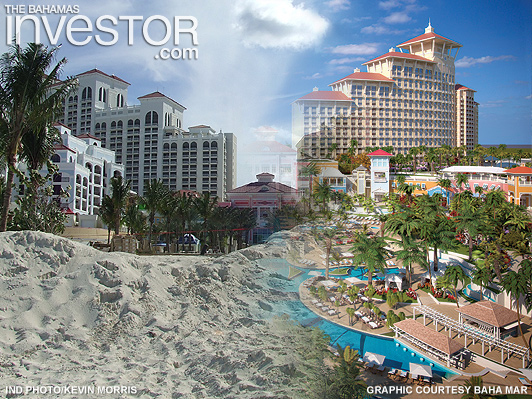| Published: Date: Updated: Author: |
The Bahamas Investor Magazine January 21, 2015 January 21, 2015 Steve Cotterill |
Ushering in a new era in tourism, the multi- billion-dollar Baha Mar luxury resort is rising out of the sand and scrubland of New Providence’s northern shore to command the Cable Beach skyline. Initially scheduled to open at the end of last year, but now poised to open this year, the resort is the brainchild of company president Sarkis Izmirlian and it stands as testimony to the development team’s vision for the future of tourism in The Bahamas.
Pictured: Mike Hong, principle architect on the Baha Mar resort project. (Photo via Mike Hong)
When Izmirlian first became involved in the project, the tourism product of Cable Beach had been challenged for several years. Paradise Island was developing quickly, leaving the Cable Beach strip somewhat in its shadow. By the early 2000s, the government decided things had to change.
“The government was looking to privatize one of the hotels on Cable Beach,” says Izmirlian. “They approached us about buying that property. Our advice was that simply having one person buy that one hotel wouldn’t solve the problem of Cable Beach.”
Without a truly outstanding destination, something unique to compel people to visit, then all you had was yet another beach hotel, argued Izmirlian at the time. Rates would then be the only distinguishing factor. “Our view was that you really had to find someone who was going to take the area and redevelop it properly. I thought that was the end of the conversation, but then the government asked us if we would like to do it. We thought about it and decided we would give it a go.”
Baha Mar master plan
An investor and developer with a bachelor of science degree in international business and finance, Izmirlian recognized that the Cable Beach tourism product failed to utilize prime real estate. “There was a whole stretch of land south of West Bay Street that wasn’t being used at all.” So, in 2004 Izmirlian enticed chief architect Mike Hong on-board and they started to work on a master plan to redevelop the whole area.
Even for the multi-award-winning founder and senior principal designer of LA-based Michael Hong Architects, it was a big task. The Korean-American designer had already built a reputation for solving complex requirements, whilst maintaining a fine balance between nature and architecture, through his work on projects such as The Gateway in Salt Lake City and the iconic Bellagio hotel in Las Vegas.
Baha Mar, however, was an altogether different proposition and presented some peculiar challenges. “When I first saw Cable Beach and what Sarkis wanted to create there, it was hard for me to imagine,” says Hong. Firstly, the proposed site covered 1,000 acres and there were existing residences, hotels, businesses, public buildings, highways and conservation areas that all had to be considered in redefining the land use. “At the beginning, all I could see were the challenges. But Sarkis was determined we could do it and that gave us a lot of confidence.”
They weren’t even sure of exactly what they were going to build.
“Our first mission was to decide what this project was going to be,” says Izmirlian. “It was in the age of big themes: resorts like Atlantis and the Las Vegas strip. So, what is our theme? What are we going to create here?” After countless hours of discussions and brainstorming, Izmirlian and his team had what he calls their “duh!” moment–the point when suddenly it all became clear: “The resort didn’t need a gimmick; we didn’t need to invent a new theme. We already had one–The Bahamas.
“The natural beauty is right in front of us. The people are right here in this country. We didn’t need to recreate it; we just needed to embrace it and put it all in one place. And that was the catalyst to create Baha Mar.”
Immense vision
With this in mind, Hong, Izmirlian and his team started to shape the blueprint for the resort.
On a scale never before seen in the region, the resort was to incorporate a dazzling array of features and facilities including: four luxury hotels, with around 3,000 rooms; the largest convention centre in The Bahamas, with 200,000 sq ft of space, which could also double as an entertainment venue and sports arena; a 100,000 sq ft casino–the largest in the Caribbean region; a 50,000 sq ft retail village with upscale retail outlets, chef-branded restaurants, and entertainment venues; a 20-acre Eco Water Park and pool experience, with three unique spas; and an 18-hole Jack Nicklaus Signature Golf Course.
Hong drew up architectural designs influenced by the natural context and even came up with what eventually would become the resort’s name. The Bahamas got its name from the Spanish word baja mar, which means shallow seas. A small adaptation created the Baha Mar moniker and it stuck. “It seemed pretty appropriate because the whole country is of the sea,” says Hong. “The natural environment informed the design. I feel that this project was unique in that a lot of other projects try to manufacture a sense of place. With Baha Mar we didn’t have to do that. We were already in the midst of timeless natural beauty.”
Hong not only drew inspiration from the island chain’s natural assets, but also its colonial legacy, with English and Spanish influences impacting the casino and hotel centrepiece. The connectivity of the campus also needed to be considered, so that people could pass easily between the different hotels, the casino and spas, while all the time only being a few metres away from the aqua parks, pools and beach. “We have designed a project, which is large, but at the same time has amazing adjacencies, so that the flows between the hotels are very good,” says Izmirlian. “Even though we have a large footprint, it makes it very easy for our customers to be able to enjoy the whole campus.”
Bahamian aesthetics
As the architectural design was being fine-tuned, a deeper dialogue started to develop about the details of how the resort should look and feel. In December 2006, Dianna Wong, principal of Dianna Wong Architecture and Interior Design, joined the team, bringing with her a multidisciplinary training in architecture, interior design, fine arts and decorative arts. A Harvard and Cambridge University graduate, Wong has been involved in a variety of iconic projects including The Beverly Hills Hotel and Caesars casino in Cairo.
Having been born in Hong Kong, raised in Montana and studied in the US and UK, Wong’s multicultural background has helped her develop a sensitivity to cultural variations, an essential skill when trying to weave the Bahamian character into a project of this size.
Right from the first meetings, Wong strove to educate herself in all things Bahamian. She started collecting postcard images, stories, photographs and even recipes during her trips to The Bahamas, creating a “vision book” which became a reference point for the whole design process. “It became a guiding vision to some extent. From that we could get the right look and feel and cultivate an emotional connection in people,” she says. “What was different about this project, and what has made it really one of the best experiences of my professional life, was that it was very design led. Often developers aren’t design minded, but at Baha Mar the design has been very much part of the strategy for success.”
Logistics and construction
There was still the little matter of making all these plans a reality. The task fell to China State Construction and Engineering Corp, which shipped in workers from China and partnered with local contractors. Throughout the building process, local businesses have tendered bids for approximately $400 million in construction projects.
Construction has so far taken nearly three years, covering a total of 3.3 million sq ft and, as with all projects of this size, there have been hitches along the way. “Construction is a series of challenges. You go from one challenge to the next and our job is to resolve them,” says Izmirlian. “If you’re building a $3.5 billion, multifaceted development anywhere in the world–I don’t care where you do it–it’s going to be incredibly challenging. I’ve done projects in the US and Europe. Issues come up constantly. So, is this complicated? Absolutely! But it is not any more complicated than a huge project anywhere. And it is huge. It is on par with the largest project anywhere in the world and it’s happening right here on our little island of New Providence.”
Lasting impact
What Baha Mar has striven to achieve is a world-class experience across a gamut of leisure activities. If you are a golfer, there is the Jack Nicklaus golf course. If you are a gamer, Baha Mar has the biggest casino in the region. If you love art, Baha Mar has the largest collection of Bahamian art anywhere in the world through partnerships with the National Art Gallery of The Bahamas, the D’Aguilar Art Foundation and the Dawn Davies Collection. If you are a nature lover, there is a 70-acre nature reserve on site and a 20-acre beachfront sanctuary, which is reserved exclusively for flora and fauna from The Bahamas. If you like shopping, there is the retail village, where products from local artisans sit side-by-side with world renowned brands. If you love luxurious comfort, you have four high-end hotels to choose from.
This is what Izmirlian hopes will attract the world’s rich and famous, glamorous and powerful. When the grand opening takes place, Baha Mar will play host to 2,500 VIP guests and the world’s media. But once it has made its grand entrance, what will be the megaresort’s lasting legacy for the country and its people?
“I think this project is going to have a transformative effect on The Bahamas,” says Izmirlian. “It really is going to trickle right through the economy. Not just in New Providence, but in all of The Bahamas.”
Baha Mar estimates that the resort will create a total of 8,000 permanent jobs for Bahamians and generate a gross domestic product contribution of $11.2 billion over a 20-year period. To distribute some of the benefits of the project throughout the archipelago, Baha Mar says it is working with farmers in Eleuthera and Andros to grow products to supply its kitchens and fishermen in the southern islands to bring in fresh locally caught fish. Its corporate social responsibility programmes include supporting local charities such as Ride for Hope and The Salvation Army, as well as ensuring the careful stewardship of island resources through conservation efforts, the resort operator claims.
“Every developer comes into a community and says that they are going to change the society for the better. That’s easy to say,” adds Izmirlian. “The hard thing is to deliver on that and I think The Bahamas is going to see that we really can deliver. We’re opening the door for the world to come and discover this amazing country.”










